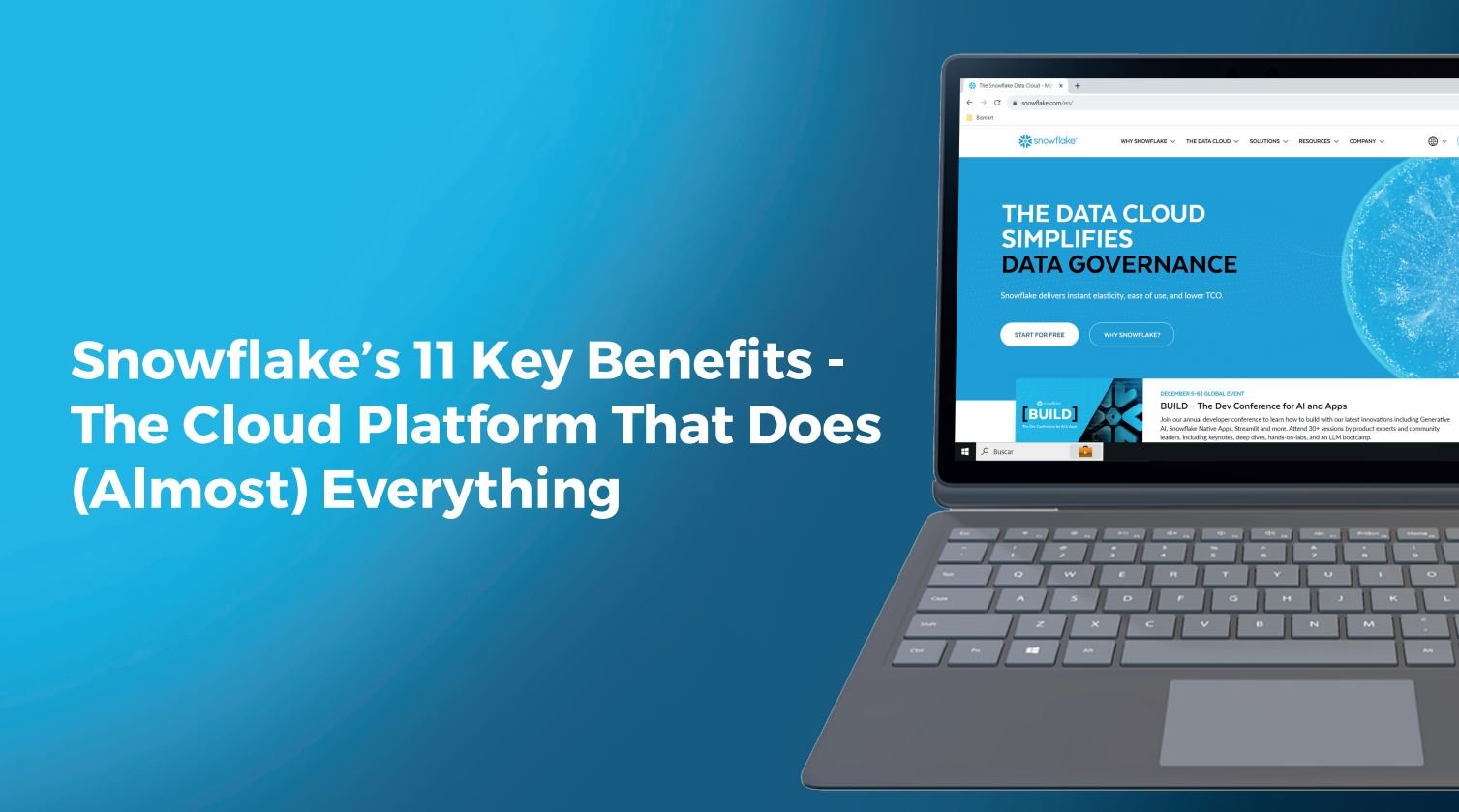Snowflake integrates data integration with data analytics. Discover the 11 big advantages of the cloud platform that can handle it all.
In a world where data management and information exchange are at the epicentre of business value generation, Snowflake provides a driver for harnessing data and transforming it into business intelligence. In this article, we explore the reasons that have made Snowflake the most trending cloud platform in the business world.

More and more companies are choosing to move their data and part of their operations to the cloud. Cloud services and environments offer significant advantages over on-premise alternatives: greater speed, more scalability and flexibility.
Companies' decision to migrate to the cloud is not random and is driven by the advantages that these environments offer. The scalability, flexibility, integration, interoperability, security and long-term savings provided by cloud environments translate into added value that on-premises systems cannot match. These benefits enable enterprises to improve their competitiveness by reducing costs in both time and staff, facilitating better IT integration and exercising more effective control over data and applications. In addition, they offer superior data security options, crucial in disaster situations, making migration to the cloud a critical strategic decision for business growth and stability.
The impact of the Covid-19 pandemic has led to an increase in the number of companies choosing to move parts of their operations to the cloud, according to a recent Microsoft report on modernisation and migration to the cloud in 2023. In response to economic uncertainty, these companies are restructuring their operations to improve scalability, ensure business continuity and optimise costs.
In this context, Snowflake, a cloud SaaS that brings data integration and data analytics together on a single platform, is positioned as an opportunity for enterprises to make the most of their data assets, while taking full advantage of all the benefits of cloud environments.
Discover the 11 big business benefits of Snowflake in our eBook: "Snowflake: the cloud platform that does (almost) everything". Position yourself on the edge of the technology wave with the new platform that's all the rage among businesses.
In a previous post on this blog we explained what Snowflake is, what does it do and what features make it a unique platform. However, let's review what it is and what it does in brief.
What is Snowflake and how does it work?
In short, Snowflake is a cloud-based data storage and data analytics platform. It is a fully managed SaaS service that allows companies to store and analyse large volumes of data in an efficient and scalable way.
Snowflake is unique in that it goes beyond data warehousing, integrating analytics, data engineering and data science into a single platform. It also excels in its ability to handle semi-structured and structured data simultaneously, and offers advanced features such as separation of storage and computation, scalable computing and secure data exchange.
Don't miss:
Snowflake's 11 big benefits for businesses
This time we focus on the benefits of Snowflake at a business level, reviewing the use cases of the platform and the functionalities that can create value for organisations.
-
Secure data exchange
One of the main reasons why so many companies are turning to Snowflake is its focus on secure data exchange.
Snowflake acts as a digital bridge within the organisation, facilitating collaboration between departments and individuals within a company and eliminating the need to copy or move data. This freedom is made possible by its advanced secure data exchange technology.
In a world where global collaboration is essential, Snowflake becomes the catalyst for connecting with strategic partners, suppliers and customers. By leveraging Snowflake's vast ecosystem, organisations can securely share data internally, as well as access a vast array of data sets from commercial data providers.
For those who need to share data with partners, Snowflake makes it easy to set up and manage data sharing. The platform offers the option to invite partners to collaborate on a project by sending them an email invitation. It also allows permissions to be configured according to the roles that each partner has in an organisation, from read-only access to full modification of shared files.
Once each user's access levels have been configured, the entire data sharing and access process can be managed from the Snowflake control panel to make it easy for everyone involved.
-
Security and flexibility
In a world where privacy and data security are essential, Snowflake provides unique security features and flexibility through an additional layer of control.
Snowflake offers advanced security features, including encryption of data at rest and in transit, role-based access control and detailed auditing.
In addition, the platform offers a number of flexible features that allow enterprises to tailor the environment to their particular data security requirements to protect consumer privacy in an increasingly complex environment.
Snowflake puts a strong focus on data protection and data management, allowing users to not only explore, but also protect, manage and govern all of their assets.
-
Data governance
The cornerstone of the new era of the data cloud is data governance, an increasingly important aspect as over-information can make it difficult to make the most of data.
Snowflake facilitates data governance by providing a command centre from which companies can understand and classify data across their entire ecosystem. This centralised management is carried out in collaboration with a network of strategic partners, enabling users to navigate the complex seas of data with confidence and clarity.
In addition, Snowflake provides the ability to unify data security and data governance in one place. All operations run on a common framework, meaning organisations can secure their data with consistency and efficiency. This convergence of security and governance in a central location not only simplifies the process, but also raises the level of protection, ensuring that data is protected from any threats.
-
It has its own data ingestion service
Snowpipe is Snowflake's data ingestion service. It is a managed service for the continuous loading of data into a data warehouse, as well as performing ETL tasks such as transformations and validations.
Snowpipe is cloud-based, so companies don't have to worry about infrastructure management and capacity planning, allowing them to focus solely on leveraging data and transforming it into valuable insights.
-
It empowers development teams
Snowflake provides advanced capabilities for develoers, enabling them to create applications and solutions faster and more efficiently by leveraging the agility and scalability of the platform.
Some of the benefits Snowflake offers to developers are:
-
Elastic scalability: Development teams can scale compute and storage resources according to the needs of their applications without worrying about managing the underlying infrastructure. Snowflake automatically handles scalability, making it easy to adapt to load spikes and changes in system demands.
-
Optimised performance: Snowflake is designed to deliver exceptional query and data analysis performance, even when dealing with large and complex data sets. Development teams can run complex queries efficiently, improving productivity and development speed.
-
Ease of use: Snowflake offers an intuitive user interface and supports standard SQL, making it easy for developers to write queries and perform analysis without having to learn a new language or complex configurations.
-
Support for multiple data types: Snowflake supports structured and semi-structured data, such as JSON and Avro. This allows developers to work with a variety of data formats without the need for complex transformations, saving time and effort in the development process.
-
Real-time collaboration: Development teams can collaborate in real-time usingowflake. They can share and access the same datasets without worrying about version conflicts, improving team collaboration and efficiency.
-
Integration with other tools and services: Snowflake easily integrates with a variety of development tools and services, such as IDEs (Integrated Development Environments) and analytics services. This allows developers to use their favourite tools to work with Snowflake and take full advantage of its functionality.
-
Smart data monetisation
Snowflake is also helpful when it comes to intelligent data monetisation. The platform acts as a digital meeting point where organisations can share their data with confidence, as it ensures the security and privacy of this data, while complying with evolving privacy rules and regulations.
By providing a secure and transparent marketplace, Snowflake enables companies to set their own prices and terms for the data they offer. This ability to set customised prices and have direct control over the monetisation process is essential for organisations wishing to maximise the value of their data. In addition, Snowflake facilitates direct transactions between sellers and buyers, eliminating unnecessary middlemen and enabling more efficient and cost-effective monetisation.
The platform also offers advanced analytical tools that enable organisations to gain a deep understanding of user behaviour and market trends. By analysing this data, companies can adjust their monetisation strategies accordingly, ensuring that the data offered is truly relevant and valuable to buyers.
In addition, Snowflake's unlimited scalability is essential for companies looking to expand their monetisation operations. They can handle large volumes of data and serve an ever-growing user base without worrying about scalability issues, allowing them to grow and adapt to market demands smoothly and efficiently.
Ultimately, Snowflake not only facilitates data monetisation, but also establishes strong and trusting relationships between sellers and buyers. By providing a secure, transparent and scalable environment for data monetisation, Snowflake creates an ecosystem in which businesses can thrive by sharing and leveraging the wealth of information available.
-
Analysis of all types of data
Snowflake is a revolution in the world of data warehousing. Unlike traditional solutions, it has the unique ability to analyse a wide range of data, regardless of its type, format or source. Whether it's data from IoT devices, unstructured audio, video and text files, or structured business intelligence workloads, Snowflake can handle it all.
What makes Snowflake truly exceptional is its ability to process massive volumes of data at astonishing speed. Despite not being a conventional columnar database or Hadoop platform, Snowflake has been designed to deliver incredible performance. It can handle petabytes or even exabytes of data, regardless of its size, shape or current location.
This flexibility and processing power allows organisations to perform advanced analytics without restrictions. Snowflake is not only limited to structured data, but can also deal with semi-structured and unstructured data, opening the door to a world of possibilities in terms of data analysis.
Its ability to handle such a wide variety of data makes it an invaluable tool for businesses that want to extract meaningful insights and make informed decisions in an increasingly complex and diverse data environment.
-
Processing of all types of data under a single query language
One of the key advantages of the platform lies in its ability to provide a consistent and unified query experience. Snowflake works with a single query language and a single execution engine. This allows structured and unstructured datasets, Big Data and relational data from multiple sources to be analysed all within a single platform without having to deal with the complexities of different query systems or languages.
This seamless integration not only improves efficiency, but also allows users to focus on interpreting results rather than worrying about the technical integration of disparate data. By providing a unified environment for performing complex and varied analyses, Snowflake simplifies the process and makes data analysis accessible and effective for a wide range of users.
9. It gets rid of maintenance and management downtime
Downtime is one of the great handicaps of cloud platforms. No matter how much planning and preparation companies do, there will inevitably be times when their data centre is down for maintenance or management. Moreover, such downtime can lead to cost overruns on cloud investments.
However, Snowflake enables companies to eliminate downtime across their entire analytics ecosystem, including data storage and processing tools such as Apache Spark and Hadoop MapReduce jobs.
Thanks to Snowflake's elastic scalability, enterprises can immediately add additional compute resources as needed without disrupting business operations or applications running on the platform.
In addition, Snowflake's "self-healing architecture" ensures high availability by continuously monitoring the health of the cluster and proactively taking corrective action if a problem occurs, all without interrupting service delivery or causing any downtime.
These capabilities promote cost savings by reducing the amount of time spent managing databases and performing database maintenance tasks manually.
10. Velocity
One of Snowflake's great added values is the speed it provides thanks to its parallel processing architecture, which executes queries simultaneously on multiple nodes, and its horizontal scalability, which allows more nodes to be added to increase processing capacity. In addition, it uses a columnar storage format that improves the speed of data retrieval, especially for queries involving large datasets. The platform also features an automatic query optimiser that dynamically adjusts the execution plan to improve efficiency and speed.
Automatic data compression and efficient storage reduce the time required to access and transfer information, contributing to faster performance. In addition, by operating directly in the cloud, Snowflake can leverage the high-performance network and storage infrastructure provided by cloud service providers, further improving the speed of data access.
11. Pay-per-use
Snowflake Data Cloud Platform is a pay-per-use model. This means you only pay for the resources, data and time you use the platform. This model helps corporations keep costs low and be agile as their business needs change over time.
Revolutionising business analytics and Big Data with Snowflake
In short, Snowflake is a cloud-based data warehouse and enterprise data management platform that combines analytics with data integration and the benefits of the cloud. It provides companies with the ability to scale their analytics needs by storing their data in one place, allowing them to handle massive amounts of information and process it quickly.
With Snowflake, companies can easily store, query and analyse massive amounts of data, both structured and unstructured, transactional and sensor data in real time.
Based on a massively parallel processing architecture, Snowflake can execute complex queries at high speed and scale seamlessly as the business grows.
If you want to explore Snowflake's business benefits in more depth, don't miss our ebook "Snowflake's 11 Big Business Benefits: The Cloud Platform That Does (Almost) Everything". You can download it for free!




